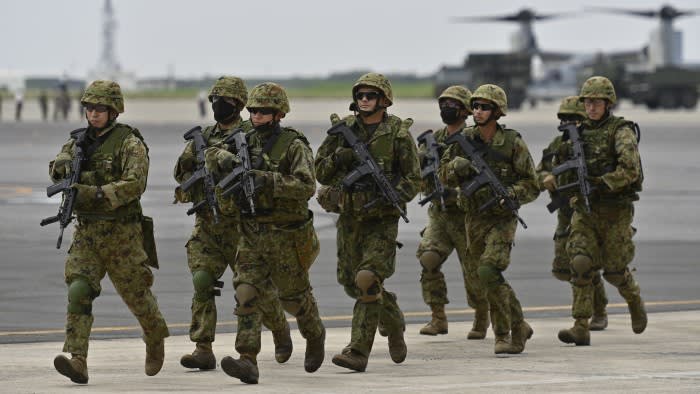The US and Japan are planning the biggest upgrade to their security alliance since they signed a mutual defence treaty in 1960 in a move to counter China.
President Joe Biden and Prime Minister Fumio Kishida will announce plans to restructure the US military command in Japan to strengthen operational planning and exercises between the nations, according to five people familiar with the situation. They will unveil the plan when Biden hosts Kishida at the White House on April 10.
The allies want to bolster their security ties to respond to what they view as a growing threat from China, which requires their militaries to co-operate and plan more seamlessly, particularly in a crisis such as a Taiwan conflict.
While Biden and Kishida will herald the strength of the US-Japan alliance, the summit will come just weeks after the US president expressed his opposition to the Japanese group Nippon Steel acquiring US Steel. The intervention was designed to boost union support before the November election, but has partly soured the otherwise strong alliance.
Japan has over the past couple of years dramatically increased its security capabilities, spending much more on defence, including plans to buy US Tomahawk cruise missiles. The Japanese military is also setting up a “Joint Operations Command” next year to improve co-ordination between the branches of its own Self-Defense Forces.
But co-ordination between the allies is hampered because US Forces Japan (USFJ) has changed little from the days when the US and Japanese militaries did less together and has little command and control authority. Japan has to deal more with US Indo-Pacific command in Hawaii, which is 19 hours behind Tokyo and 6,200km away.

“Japan’s new national security policy is the most positive security development in east Asia in this century. The recognition that our two nations’ defence strategies have converged makes improvement in our day-to-day command and control the logical next step,” said Philip Davidson, who retired as Indo-Pacific commander in 2021.
Tokyo has long urged the US to give the three-star USFJ commander more operational authority, saying closer co-ordination on the ground was needed.
One catalyst was the 2011 earthquake and tsunami when US and Japanese troops carried out a joint rescue operation. While it was a success, Ryoichi Oriki, then chief of Japan’s SDF joint staff, said it was inconvenient having to co-ordinate with Indo-Pacific command in Hawaii rather than the USFJ commander, his daily counterpart.
Tokyo says there is an urgent need to put a more senior US officer in Japan as it takes on a bigger regional defence role. “It sends a strong strategic signal to China and North Korea and it’s meaningful from the point of view of deterrence to say that the US will strengthen the command structure in Japan,” Oriki told the Financial Times.
One model the Biden administration is considering involves creating a new US military joint task force that would be attached to US Pacific Fleet, one of the component commands at Indo-Pacom in Hawaii. The fleet’s four-star commander would spend more time in Japan than at present and would have an enhanced support structure in the country. Over time, the task force, which would include different parts of the US military, would shift to Japan.

Christopher Johnstone, a former senior Pentagon and CIA official, said upgrading the US command would be a “big step in building a more credible bilateral military alliance”.
“Co-locating these commands, at least partially, would move the US-Japan alliance closer to the ‘fight tonight’ mantra of the US alliance with South Korea — more responsive and credible in responding to regional threats,” said Johnstone, now at the CSIS think-tank. “This would make a major contribution to deterrence in the region.”
James Schoff, a US-Japan alliance expert at the Sasakawa Peace Foundation USA, said the two allies needed to strengthen and clarify leadership and operational relationships for planning in both peacetime and times of crisis.
“US leadership could potentially ‘commute’ from Hawaii to Japan for this in peacetime, but they’ll need some kind of full-time joint staff based in Japan to plan, facilitate, and build trust with Japanese counterparts for a practical set of bilateral missions,” Schoff added.
People familiar with the situation cautioned that other models could also be considered, including the possibility of upgrading USFJ. The Pentagon is some way from making any decision, including on the task force idea, which was proposed by Admiral John Aquilino, the Indo-Pacific commander. Defence secretary Lloyd Austin also wants to give Admiral Samuel Paparo, who will succeed Aquilino in May, a chance to weigh in after he assumes the role.
The US and Japanese foreign and defence ministers are also expected to discuss the issue together later this year.
The White House, Pentagon and Indo-Pacom declined to comment. The Japanese government also did not comment.
Whatever model is chosen will be complicated because of questions about resources and infrastructure and issues related to military hierarchy. There will also probably be turf battles between the different services in the US military.
Tokyo has been pushing for a US four-star commander in Japan. But the idea faces resistance, including on Capitol Hill. Jack Reed, the Democratic head of the Senate armed services committee, recently told the Defense Writers Group that Aquilino had done a “superb” job in his contact with the Japanese and that the current structure was “adequate”.
Asked by the FT if a four-star officer was necessary in Japan, Reed added: “Maybe in the future, but right now I think we have the command structure in place to carry out an effective response.”
